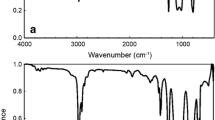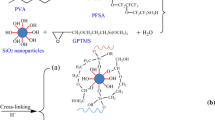Abstract
Thermal crosslinked double-network poly (vinyl alcohol) (PVA) is prepared by applying the sequential method. The obtained membrane is characterized by thermogravimetric analysis (TGA), scanning electron microscope (SEM), Fourier transform infrared (FTIR) spectroscopy and contact angle analyses. It is concluded from FTIR analysis, contact angle measurements and measuring of swelling degree at different feed concentrations that the interpenetrating of the second network, that is the double network (DN), decreases the hydrophilicity of the membrane, while improving the thermal behavior and stability under high temperature. For the sake of the comparison of PVA and DN-PVAs selectivity, total permeation flux, individual fluxes and pervaporation separation index are evaluated for the dehydration of ethanol solution with a feed composition of 85/15 wt% ethanol/water solution at 40–60 °C. Furthermore, the effect of feed temperature on the permeation flux is expressed by the Arrhenius relationship. The performance of DN-PVAs membrane is appraised according to the change in feed concentration and operating temperature. The ethanol concentration in the feed is 75–95 wt% the DN-PVAs has flux values in the range of 41–414 g/m2 h and separation factor of 105–376 at the operating temperature 40–60 °C.











Similar content being viewed by others
References
Abels C, Carstensen F, Wessling M (2013) Membrane processes in biorefinery applications. J Membr Sci 444:285–317
Baker WR, Wijmans JG, Huang Y (2010) Permeability, permeance and selectivity: a preferred way of reporting pervaporation performance data. J Membr Sci 348:346–352. https://doi.org/10.1016/j.memsci.2009.11.022
Balat M, Balat H (2009) Recent trends in global production and utilization of bio-ethanol fuel. Appl Energy 86:2273–2282
Bolto B, Tran T, Hoang M, Xie Z (2009) Crosslinked poly(vinyl alcohol) membranes. Progress Polym Sci 24:969–981
Bolto B, Hoang M, Xie Z (2011) A review of membrane selection for the dehydration of aqueous ethanol by pervaporation. Chem Eng Process 50:227–235
Brüschke HEA, Wynn NP (2000) Pervaporation Membrane technology and research. Menlo Park, CA, USA
Byron PR, Dalby RN (1987) Effects of heat treatment on the permeability of polyvinyl alcohol films to a hydrophilic solute. J Pharm Sci 76:65–76
Chapman PD, Oliveira T, Livingston AG, Li K (2008) Membranes for the dehydration of solvents by pervaporation. J Membr Sci 318:5–37
Chaudhari S, Kwon Y, Moon M, Shon M, Nam S, Park Y (2017) Poly(vinyl alcohol) and poly(vinylamine) blend membranes for isopropanol dehydration. J Appl Polym Sci. https://doi.org/10.1002/app.45572
Feng X, Huang RYM (1997) Liquid separation by membrane pervaporation. Ind Eng Chem Res 36:1048–1066
Figoli A, Santoro S, Galiano F, Basile A (2015) Pervaporation membranes: preparation, characterization, and application. In: Basile A, Figoli A, Khayet M (eds) Pervaporation, vapour permeation and membrane distillation principles and applications. Elseiver, Amsterdam
Galya T, Sedlarík V, Kuritka I, Novotny´ R, Sedlaíková J, Sáha P (2008) Antibacterial Poly(vinyl Alcohol) film containing silver nanoparticles: preparation and characterization. J Appl Polym Sci 110:3178–3185. https://doi.org/10.1002/app.28908
Gohil JM, Bhattacharya A, Ray P (2006) Studies on the cross-linking of Poly(Vinyl Alcohol). J Polym Res 13:161–169
Gong JP, Katsuyama Y, Kurokawa T, Osada Y (2003) Double-network hydrogels with extremely high mechanical strength. Adv Mater 15:1155–1158
González-Campos JB et al (2012) Molecular dynamics analysis of PVA-AgnP composites by dielectric spectroscopy. J Nanomater 2012:11. https://doi.org/10.1155/2012/925750
Hasimi A, Stavropoulou A, Papadokostaki KG, Sanopoulou M (2008) Transport of water in polyvinyl alcohol films: effect of thermal treatment and chemical crosslinking. Eur Polymer J 44:4098–4107
Hodge RM, Bastow TJ, Edward GH, Simon GP, Hill AJ (1996) Free volume and the mechanism of plasticization in water-swollen Poly(vinyl alcohol). Macromolecules 29:8137–8143. https://doi.org/10.1021/ma951073j
Huang RYM, Yeom CK (1990) Pervaporation separation of aqueous mixtures using crosslinked poly(vinyl alcohol) (PVA). II. Permeation of ethanol-water mixtures. J Membr Sci 51:213–292
Hyder MN (2008) Preparation, characterization and performance of Poly(vinyl alcohol) based membranes for pervaporation dehydration of alcohols. University of Waterloo
Jiang LY, Wang Y, Chung T-S, Qiao XY, Lai J-Y (2009) Polyimides membranes for pervaporation and biofuels separation. Prog Polym Sci 34:1135–1160
Katz MG, Wydeven T (1982) Selective permeability of PVA membranes. II. Heat-treated membranes. J Appl Polym Sci 27:79–87
Li B-B, Xu Z-L, Qusay FA, Li R (2006) Chitosan-poly (vinyl alcohol)/poly (acrylonitrile) (CS–PVA/PAN) composite pervaporation membranes for the separation of ethanol–water solutions. Desalination 193:171–181
Li Y, Verbiest T, Strobbe R, Vankelecom IFJ (2013) Improving the performance of pervaporation membranes via localized heating through incorporation of silver nanoparticles Journal of Materials Chemistry A
Mallapragada SK, Peppas NA (1996) Dissolution mechanism of semicrystalline poly(vinyl alcohol) in water. J Polym Sci Part B: Polym Phys 34:1339–1346
Mansur SH, Sadahira MC, Souza NA, Mansur APA (2008) FTIR spectroscopy characterization of poly (vinyl alcohol) hydrogel with different hydrolysis degree and chemically crosslinked with glutaraldehyde. Mater Sci Eng C 28:539–548
Meng XJ, Liu QL, Zhu AM, Zhang QG (2010) Amino-functionalized poly(vinyl alcohol) membranes for enhanced water permselectivity. J Membr Sci 360:276–283
Noorjahan A, Choi P (2015) Effect of free volume redistribution on the diffusivity of water and benzene in poly(vinyl alcohol). Chem Eng Sci 121:258–267
Park J-S, Park J-W, Ruckenstein E (2001) On the viscoelastic properties of Poly(vinyl alcohol) and chemically crosslinked Poly(vinyl alcohol). J Appl Polym Sci 82:1816–1823
Praptowidodo VS (2005) Influence of swelling on water transport through PVA-based membrane. J Mol Struct 739:207–212
Premakshi HG, Sajjan AM, Kittur AA, Kariduraganavar MY (2015) Enhancement of pervaporation performance of composite membranes through in situ generation of silver nanoparticles in poly(vinyl alcohol) matrix. J Appl Polym Sci 132:1–11. https://doi.org/10.1002/app.41248
Ruckensien E, Liang L (1996) Pervaporation of ethanol-water through polyvinylalcohol–polyacrylamide interpenetrating polymer network membranes unsupported and supported on polyethersulfone ultrafiltration membranes: a comparison. J Membr Sci 110:99–107
Ruckenstein E, Liang L (1996) Poly(acrylic acid)-poly(vinyl alcohol) semi- and interpenetrating polymer network pervaporation membranes. J Appl Polym Sci 62:973–987
Schaetzel P, Vauclair C, Nguyen QT, Bouzerar R (2004) A simplified solution–diffusion theory in pervaporation: the total solvent volume fraction model. J Membr Sci 44:117–127. https://doi.org/10.1016/j.memsci.2004.06.060
Singha NR, Kar S, Ray S, Ray SK (2009) Separation of isopropyl alcohol-water mixtures by pervaporation using crosslink IPN membranes. Chem Eng Process 48:1020–1029
Ueda Y, Tanaka T, Iizuka A, Sakai Y, Kojima T, Satokawa S, Yamasaki A (2011) Membrane separation of ethanol from mixtures of gasoline and bioethanol with heat-treated PVA membranes. Ind Eng Chem Res 50:1023–1027
Valentínyi N, Cséfalvay E, Mizsey P (2013) Modelling of pervaporation: parameter estimation and model development. Chem Eng Res Des 91:174–183
Vane LM (2008) Separation technologies for recovery and dehydration of alcohols from fermentation broths Biofuels. Bioprod Bioref 2:553–588
Vodnik VV, Aponjic´ ZS, Dzˇunuzovic´ JV, Bogdanovic´ U, Mitric´ M, Nedeljkovic´ J (2013) Anisotropic silver nanoparticles as filler for the formation of hybrid nanocomposites. Mater Res Bull 48:52–57
Wijmans JG, Baker RW (1995) The solution-diffusion model: a review. J Membr Sci. https://doi.org/10.1016/0376-7388(95)00102-i
Xia LL, Li CL, Wang Y (2016) In-situ crosslinked PVA/organosilica hybrid membranes for pervaporation separations. J Membr Sci 498:263–275
Xue-Hui L, Le-Fu W, Li-Qiu Z (1998) Preparation of PVA/PAN pervaporation composite membrane and their separation properties. J Nat Gas Chem 7:361–368
Yeom CK, Huang RY (1992) Modelling of the pervaporation separation of ethanol-water mixtures through crosslinked poly (vinyl alcohol) membrane. J Membr Sci 67:39–55
Zhang H, Wang Y (2016) Poly(vinyl alcohol)/ZIF-8-NH 2 mixed matrix membranes for ethanol dehydration via pervaporation. AIChE J 62:1728–1739
Zhang Y, Ye L (2014) Structure and property of polyvinyl alcohol/precipitated silica composite hydrogels for microorganism immobilization. Compos B Eng 56:749–755
Zhang QG, Liu QL, Jiang ZY, Chen Y (2007) Anti-trade-off in dehydration of ethanol by novel PVA/APTEOS hybrid membranes. J Membr Sci 287:237–245
Zhang QG, Liu QL, Zhu AM, Xiong Y, Ren L (2009) Pervaporation performance of quaternized poly(vinyl alcohol)and its crosslinked membranes for the dehydration of ethanol. J Membr Sci 335:68–75
Acknowledgement
This research was supported by the Hungarian Scientific Research Fund, OTKA, and Grant No. 112699. Miskolc project.
Author information
Authors and Affiliations
Corresponding author
Ethics declarations
Conflicts of interest
All authors confirm that no potential conflict of interest was reported.
Rights and permissions
About this article
Cite this article
Selim, A., Valentínyi, N. & Mizsey, P. Influence of double-network interpenetration on ethanol dehydration performance of PVA-based pervaporation membranes. Chem. Pap. 73, 1069–1081 (2019). https://doi.org/10.1007/s11696-018-0658-5
Received:
Accepted:
Published:
Issue Date:
DOI: https://doi.org/10.1007/s11696-018-0658-5




